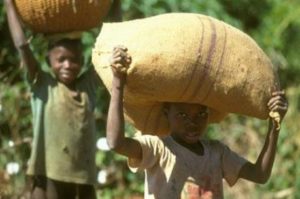Child labour prevalence rate high in Africa – Report
 Close to 21 million people globally are estimated to be victims of bonded labour, slavery, forced prostitution and other forms of involuntarily work, according to the 2013 World Development report.
Close to 21 million people globally are estimated to be victims of bonded labour, slavery, forced prostitution and other forms of involuntarily work, according to the 2013 World Development report.
According to estimates from the International Labour Organisation (ILO), almost half of the child labourers, representing 72.1 million of the 152 million victims of child labour worldwide were found in Africa.
It was worrisome to note that in terms of prevalence, one in five children in Africa, presenting 19.6 per cent were in child labour, compared to between three per cent and seven per cent prevalence in other regions of the world, with overwhelming concentration in agriculture including fishing, forestry, animal husbandry and aquaculture, which are predominant occupations in almost all African countries.
Interestingly, many African countries have ratified the Conventions on Forced Labour, Child Labour and Discrimination, with many of our national laws prohibiting child labour in all its forms.
In Ghana, the Ghana Living Standard Survey (GLSS) puts child labour statistics at an incredibly high rate of 21.8 per cent, a rate which the Minister of Employment and Labour Relations, Mr Ignatius Baffour Awuah described as unacceptable at the just ended joint Regional Workshop in Accra for Rural Workers’ and Small Producers’ organisations.
The Minister described the scenario as frightening, and called for renewed, intensified and concerted effort to realise the objectives of alliance 8.7 as well as the SDGs target 8.7 and eradication of all forms of child labour by 2025.
The four-day workshop was jointly organized by the ILO, Food and Agriculture Organisation (FAO) and the General Agricultural Workers’ Union (GAWU) of Trades Union Congress (TUC) – Ghana to exchange experiences and ideas of organising against child labour in Africa.
Participants from 16 African countries and four organisations from Europe attended the workshop, which also aimed at sharing in Ghana’s success story in addressing child labour through the Torkor Model in the Kpando Municipal Assembly, Volta Region.
The Torkor Model is being championed by GAWU to eradicate child labour in that part of the Region using its three core components, namely, organising of informal workers, social mobilisation through sensitisation and capacity building, and knowledge sharing.
The project, which started in 2004 had since withdrawn about 4,500 children from child labour, anti-trafficking, bonded labour and slave-like practices and send them to school; registered about 1,425 farmers and fishermen as members of GAWU, thus encouraging adult labour and decent work; and setting up of 40 mini factories for enhanced alternative livelihood activities and increasing incomes within the agricultural value chain in the country.
GAWU also with the help of the Ghana Navy trained 15 divers to replace work done by children and also provided a first point of call in case of accident on the lake; it has also develop infrastructure and community monitoring and sensitisation schemes such as a surveillance system to monitor operations on the lake by the use of security camera and locally-manufactured speed boat, among others.
Mr Edward Kareweh, General Secretary of GAWU, said harnessing the rural economy’s potential to create decent and productive jobs and shared prosperity was imperative to achieving sustainable development and equitable economic growth.
However, he said, rural areas in many economies and in all regions were characterised by significant decent work deficits, saying “Unions therefore cannot pretend not to notice what is happening”.
“It is therefore important to note that the employment of children deprives adults of employment and once children cannot be unionised the union membership is reduced.
“GAWU as a Union of change is therefore committed to the tenets of decent work and has an objective of creating and operating within child labour free zones,” he added.
Mr Bukar Tijani, Assistant Director-General, Regional Representative for Africa, said Africa has the highest percentage and prevalence rate of child labour, and that clearly enjoined all partners in the region to intensify actions to eradicate it.
To that effect, the ILO, IUF and FAO have formed partnerships with other stakeholders in the sector to ensure that the issue of child labour was addressed, he said.
Mr Tijani urged all participants to be pro-active, interactive and openly share ideas and experiences on the menace in order to come out with implementable action points to catch the attention of policy makers and implementers.
Mr Andrews Tagoe, Deputy General Secretary of GAWU, said areas for future work and support include looking for funding to replicate the Torkor Model in the rest of the 11 Districts of the entire Volta Lake to cover both supply and demand communities’ sides of child labour, forced labour, modern slavery and human trafficking.
He said the Union has acquired a four-acre plot at Kpando Torkor to construct a resource centre to be used as a learning and exchange centre on the Torkor model, adding that, they hope to collaborate with foreign partners to realise that dream.
Mr Freeman Gadri, a rescued child, who was supported by GAWU and its partners, is now an accountant was present at the workshop.
He appealed to parents to invest in their wards’ education and desist from the practice.
He also urged both governments and civil society organisations to “stop the talking” and go ahead to fix the problem.
“If everybody is saying it is poverty that is forcing people to indulge in child labour, then it is about time governments put in policies to address poverty by creating more jobs as well as enabling environment for investors,” he said.
He was grateful to GAWU and its partners for supporting him and other children to achieve their dreams and urged them to extend the programme to the remaining districts to achieve total eradication of child labour in the municipality.
Source: GNA
